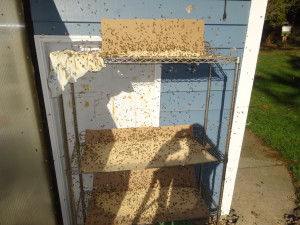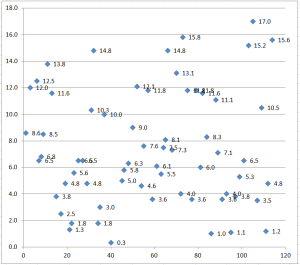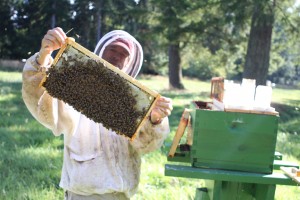For this year the mite levels remained about the same as the previous year. Not much value added in posting.
Mite Test Data is on the Y-axis. The Hive Number is on the X-axis. All mite count data has been scaled per 100 bees. The fall in the Northwest is the time of the year when the mite count reaches its maximum.Â
The colonies are nearly broodless and all the mites reside on bees and will be part of the count. I will have spring deadout data and will be able to compare to mite levels to see if a critical threshold level can be estimated. I have no comments on the levels at this time. I do feel they are higher than I would like. I’ve never taken more data than last fall in an effort to determine why I have been unsuccessful in stabilizing the mite levels across my colonies. Wide swings in mite levels continue with 50% of the queens produced having very low mite levels and the rest are somewhere in between.
The test criteria used a generous one cup of bees. This assumes 600 bees. I haven’t counted them but some have said there could be 800 bees/cup. If there are more, the data needs to be further scaled showing a lower mite count across the board. Testing for 2017 will be changed to only using 1/2 cup of bees. This will accelerated the mite counting time so I can get to more hives in one day. Less sugar will also be used/reused after sifting. I believe the accuracy will still be quite high.
Below is a typical custom built setup I use as a nuc box. Each of the three divided sections has three deep frames for easy transference to full size hives. Remember your whole operation has to work smoothly. You don’t want to be working with toy frames that give you such a limited amount of eggs that grading queen laying is next to impossible. Ask yourself whether you can pull a frame from here and put it there. If the answer is no then rethink what your are doing. Some work with medium size boxes that are a little less stressful on the back. That is fine, just use frames that will fit throughout. This means your nuc’s should use medium size frames as well.
http://www.northwestqueens.com/site/work-in-progress/dsc03102/” rel=”attachment wp-att-529″>
Pictured on the right I’m feeding out pollen in early February. What I’ve done is place pollen substitute on racks under a roof eve to keep the rain off. This is a soy based pollen like Bee-Pro. This is done as a monitoring tool. I can tell without opening the hive that the bees are beginning to brood up as they start to get spring feelings. Also just as soon as natural sources start showing up they will stop taking this non-natural source of pollen almost overnight. When it is raining a number of the more Northwest savvy bees will still show up. By monitoring the hives that are working it is now possible to use this information as a selection tool on who to breed from. So you’ve answered three questions: 1. are they brooding, 2. are natural sources of pollen available, and 3. I work in cooler weather and might be a first choice to breed from over an equally rated hive.
Changing an Apiary to Single Genetic Line
I assume the intent is to establish an apiary that will flood the area with your drones and help control the flying drones available for mating. You need to check for other bee keepers within five miles radius and make a map of how many hives and the locations of each that might pollute your drone pool. If the hive count is reasonable and the fellow beekeepers are agreeable you could offer to replace all their queens with your genetics. This could be beneficial to everybody involved.
Step 1.
Remove all the queens from every hive (optional if forced supersedure is used via queen cell introduction as stated) and follow up with a queen cells from your new genetic line. These cells could be from a number of your best breeder candidates. This can be done at any point within the successful mating period of the season. Other factors like available drone, good weather play a role as well. Recheck the hive marking each queen and observing the appropriate brood break associated with the new queen laying to confirm you have your queen from the cell you placed. You want to be sure you were successful. Once completed all the new drones from the replacement queens will carry the new line of genetics regardless of who she mated with. This is a pretty low cost method of removing sick treated bees from your drone pool.

